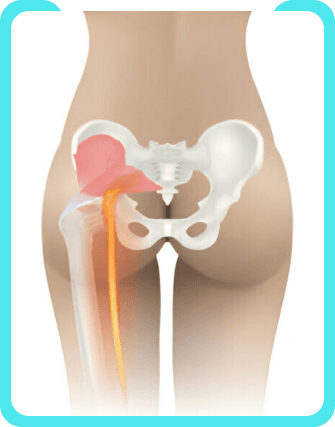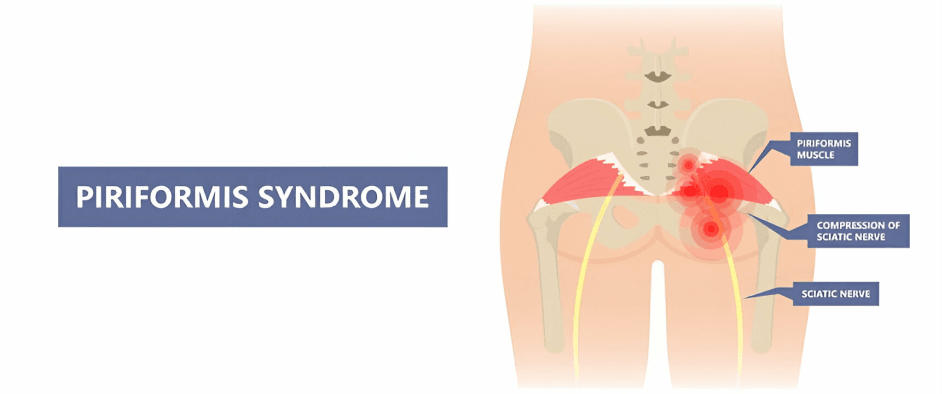
Piriformis Syndrome
- Home
- Conditions
- Back & Spine Conditions
- Piriformis Syndrome
This condition causes symptoms like true sciatica due to irritation of the sciatic nerve by the piriformis muscle. Some of the common synonyms are wallet neuritis, , deep gluteal syndrome. It has a preponderance for women with the ratio of prevalence of the same is 6:1.
The piriformis is a muscle that extends from the front of the sacrum. That’s the triangle-shaped bone between your two hipbones in your pelvis. The muscle extends across the sciatic nerve to the top of the femur. The femur is the large bone in your upper leg.
The piriformis helps the thigh move side to side. A piriformis muscle spasm can put pressure on the sciatic nerve and cause symptoms. The result is piriformis syndrome.
The sciatic nerve is a thick and long nerve in the body. It passes alongside or goes through the piriformis muscle, goes down the back of the leg, and eventually branches off into smaller nerves that end in the feet. Nerve compression can be caused by spasm of the piriformis muscle.

Treatment for Piriformis Syndrome
Piriformis Syndrome Causes
Muscle spasm in the piriformis muscle causing irritation of the sciatic nerve.Muscle spasms of the PM are most often caused by direct trauma, post-surgical injury, lumbar and sacroiliac joint pathologies or overuse
Hematoma in the piriformis muscle formed in the muscle after a fall on the buttock can irritate the sciatic nerve.
Swelling and tightness in the piriformis as a response to injury or spasm.
Even once the injured piriformis heals there is scar tissue which is not as flexible and can irritate the sciatic nerve
Activities- prolonged sitting on a hard surface with wallet in the backpocket, exercise on hard and irregular surface, exercise after a long lay off.
Symptoms
- Sciatica with radiating pain starting from the buttocks going along the back of the leg to the outer border of foot.
- Buttock pain which is of a dull achy character Associated tingling and numbness. Weakness in lower limbs or reduced sensation is quite rare.
- Sitting is particularly painful and difficult with patients preferring to her old the affected buttock a little up while sitting
- Aggravated by adduction and internal rotation and Pain can lessen on the patient lying down, bending the knee or on walking.

Diagnosis
- X rays are not helpful
- Nerve Conduction studies and MRI can help us towards the diagnosis on correlation with Clinical findings but even these are not helpful all the times.
- An injection of local anesthetic under USG or fluoroscopy is considered the most definitive means of diagnosis.
Treatment
- Rest, NSAIDS and muscle relaxants are used initially.
- Physical therapy has a very important role as many cases can resolve with focussed exercises.
- Modalities that are used are Ultrasound massage, Deep Tissue Release techniques with a structured program for piriformis and hamstring stretches.
- Patients not responding to these have an option of receiving USG or Fluoroscopy guided injections of LA+steroid.
- PRP (Platelet-Rich Plasma) Therapy: Utilizes growth factors from your own blood to promote healing and reduce inflammation in the piriformis muscle.
- Prolotherapy: Injections stimulate tissue repair and strengthen the piriformis muscle to relieve pain.
- BOTOX can also be given as it causes functional denervation of muscle and relieve the spasm
- Surgical options include release of the tendon at the attachment on the greater trochanter, dissection through the piriformis muscle or neurolysis of the sciatic nerve
Intra op fluoroscopy images of piriformis injection

Contrast dye spread of piriformis

Intra op fluoroscopy images of piriformis injection
At Alleviate
we offer specialized treatments for piriformis syndrome, a common cause of buttock and leg pain
- Intra-Muscular Injections: Options include PRP therapy for healing, prolotherapy for muscle strengthening, and Botox injections for functional denervation of muscle and relieve the spasm
- Physiotherapy: Customized programs including manual therapy and targeted exercises to improve flexibility and reduce pain.
Video Spotlight
Blog
Surgery-Free Solutions
Expert Tips for Pain Management
Testimonials
Words From Our Patients
I had consulted Dr Swagatesh Bastia for my mom’s hip pain. The doctor was patient enough to listen to all the challenges what she faced. This I found as a good quality since in majority of the cases, doctors are always in a hurry without even ready to be attentive listeners to the patients who come with illnesses. The doctor was also not in a rush to diagnose something at the overview level and prescribe medicines and treatments rather went into a detailed diagnosis. Based on his suggestion the Physiotherapy sessions also helped my mom to feel better. All the physiotherapists who did the sessions for mom were professional, emphathetic and considerate about what my mom was going through and dealt with her accordingly. Overall happy with the consultation and the Physio sessions undertaken at Alleviate Pain Management Clinic Dasarahalli.
I was suffering from a pain on left buttocks. I consulted neurologists and they suggested for an MRI. There was no significant problem shown in MRI.I took medicine for about 2.months and there was no cure. I was unable to sit on chair and also in car. Later i consulted alleviate pain hospital dasarahalli. Dr. Wiquar sir has attended me and explained the cause of pain which is Piriformis syndrime .He suggested for an injection therapy and i have undergone it. It took about 15 minutes. I was very much scared but the procedure went very smooth. I took physiotherapy for two weeks and doing very well now. Thanks to hema and chaitra (physiotherapist) for their work. A big thanks to Wiquar sir for helping me to come out of the pain.






